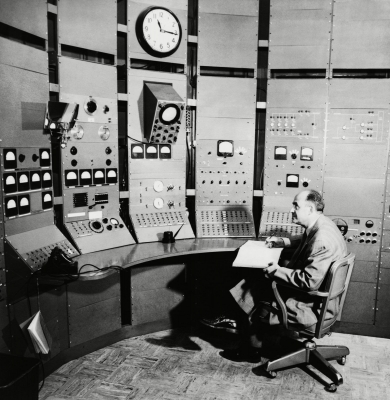
When the United States entered World War II in December 1941, nuclear research was consolidated to some degree. Fermi had built a series of “piles,” as he called them, at Columbia. Now he moved to the University of Chicago, where he continued to construct piles in a space under the stands of the football field. The final structure, a flattened sphere about 7.5 metres (25 feet) in diameter, contained 380 tons of graphite blocks as the moderator and 6 tons of uranium metal and 40 tons of uranium oxide as the fuel, distributed in a careful pattern. The pile went “critical” on December 2, 1942, proving that a nuclear reaction could be initiated, controlled, and stopped. Chicago Pile-1, as it was called, was the first prototype for several large nuclear reactors constructed at Hanford, Washington, where plutonium, a man-made element heavier than uranium, was produced. Plutonium also could fission and thus was another route to the atomic bomb.
Since the war, science had been recognized in the United States as highly important to national security. Fermi largely avoided politics, but he did agree to serve on the General Advisory Committee (GAC), which counseled the five commissioners of the Atomic Energy Commission. In response to the revelation in September 1949 that the Soviet Union had detonated an atomic bomb, many Americans urged the government to try to construct a thermonuclear bomb, which can be orders of magnitude more powerful. GAC was publicly unanimous in opposing this step, mostly on technical grounds, with Fermi and Isidor Rabi going further by introducing an ethical question into so-called “objective” advice. Such a bomb, they wrote, “becomes a weapon which in practical effect is almost one of genocide…. It is necessarily an evil thing considered in any light.” U.S. Pres. Harry S. Truman decided otherwise, and a loyal Fermi went for a time back to Los Alamos to assist in the development of fusion weapons, however with the hope that they might prove impossible to construct.
Fermi primarily investigated subatomic particles, particularly pi mesons and muons, after returning to Chicago. He was also known as a superb teacher, and many of his lectures are still in print. During his later years he raised a question now known as the Fermi paradox: “Where is everybody?” He was asking why no extraterrestrial civilizations seemed to be around to be detected, despite the great size and age of the universe. He pessimistically thought that the answer might involve nuclear annihilation.
Credit : Britannica
Picture Credit : Google




